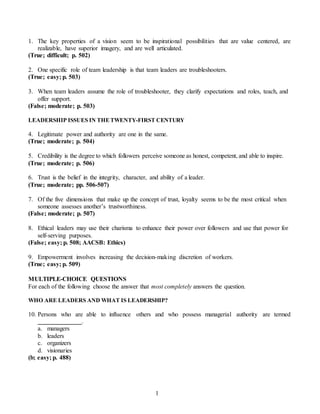Ch.1b.docx
- 1. 1 1. The key properties of a vision seem to be inspirational possibilities that are value centered, are realizable, have superior imagery, and are well articulated. (True; difficult; p. 502) 2. One specific role of team leadership is that team leaders are troubleshooters. (True; easy; p. 503) 3. When team leaders assume the role of troubleshooter, they clarify expectations and roles, teach, and offer support. (False; moderate; p. 503) LEADERSHIP ISSUES IN THETWENTY-FIRST CENTURY 4. Legitimate power and authority are one in the same. (True; moderate; p. 504) 5. Credibility is the degree to which followers perceive someone as honest, competent, and able to inspire. (True; moderate; p. 506) 6. Trust is the belief in the integrity, character, and ability of a leader. (True; moderate; pp. 506-507) 7. Of the five dimensions that make up the concept of trust, loyalty seems to be the most critical when someone assesses anotherâs trustworthiness. (False; moderate; p. 507) 8. Ethical leaders may use their charisma to enhance their power over followers and use that power for self-serving purposes. (False; easy; p. 508; AACSB: Ethics) 9. Empowerment involves increasing the decision-making discretion of workers. (True; easy; p. 509) MULTIPLE-CHOICE QUESTIONS For each of the following choose the answer that most completely answers the question. WHO ARE LEADERS AND WHAT IS LEADERSHIP? 10. Persons who are able to influence others and who possess managerial authority are termed . a. managers b. leaders c. organizers d. visionaries (b; easy; p. 488)
- 2. 2 11. Leadership is . a. the process of influencing a group toward the achievement of goals b. a group that achieves goals c. the function of influencing a group towards the achievement of goals d. directing a group towards the achievement of goals (a; difficult; p. 488) EARLY LEADERSHIPTHEORIES 12. Leadership . a. has a requirement of at least five members to be led b. is based on management direction c. research has shown that it cannot be developed d. has only been studied since the early twentieth century (d; moderate; p. 488) 13. Early leadership trait research sought . a. to clarify the need for leadership traits b. and found the traits status of leaders c. identification of traits that leaders could use d. characteristics that might differentiate leaders from nonleaders (d; difficult; p. 488) 14. Trait theory ignores . a. the interactions of leaders b. the characteristics of the group members c. the interactions of leaders and their group members as well as situational factors d. situational factors in the leadership research (c; moderate; p. 489) 15. The University of Iowa studies discussed all of the following leadership styles except . a. laissez-faire b. democratic c. accommodating d. autocratic (c; moderate; p. 490) 16. Which of the following describes the leadership style in which a leader tends to centralize authority, dictate work methods, make unilateral decisions, and limit employee participation? a. cultural style b. autocratic style c. democratic style d. laissez-faire style (b; moderate; p. 490)

